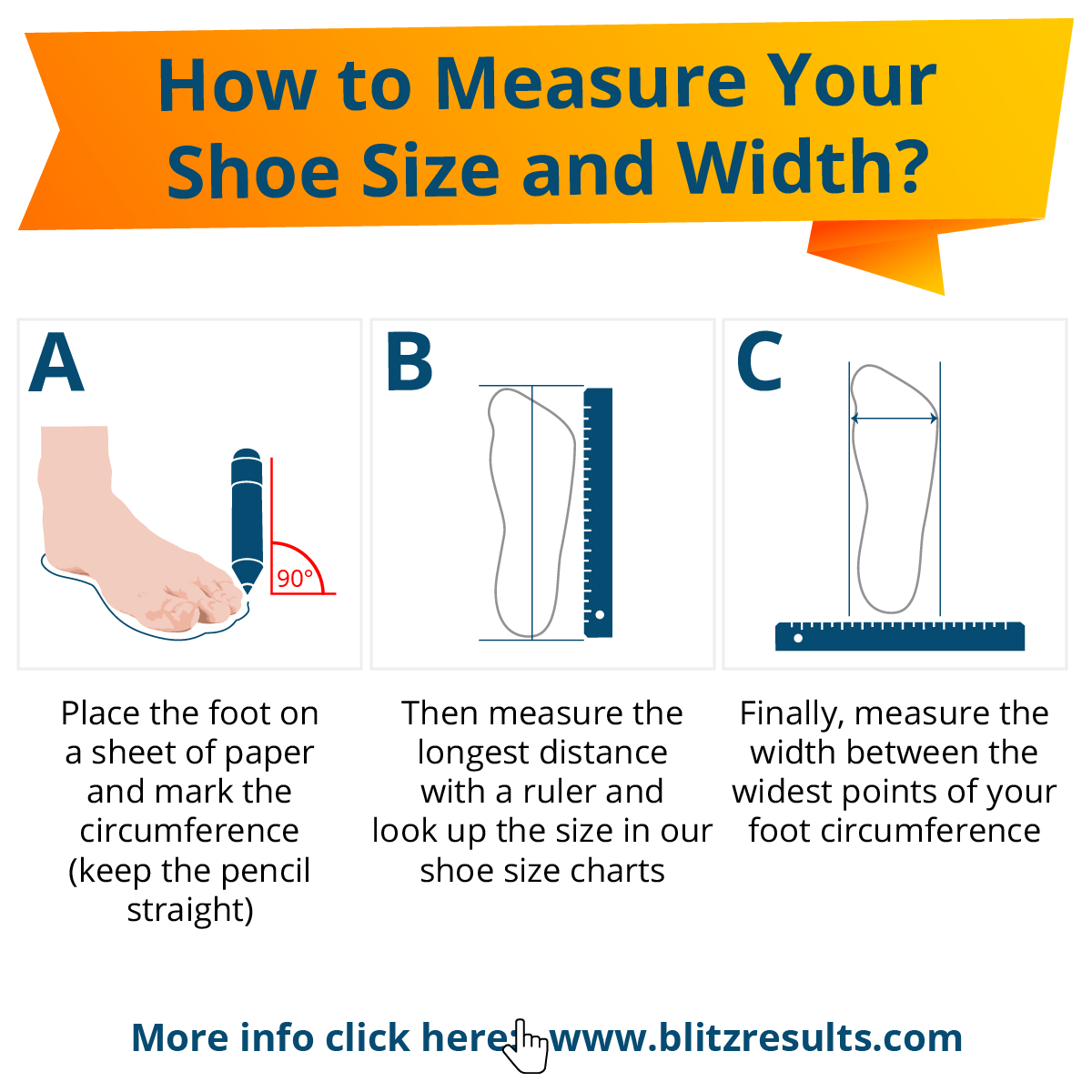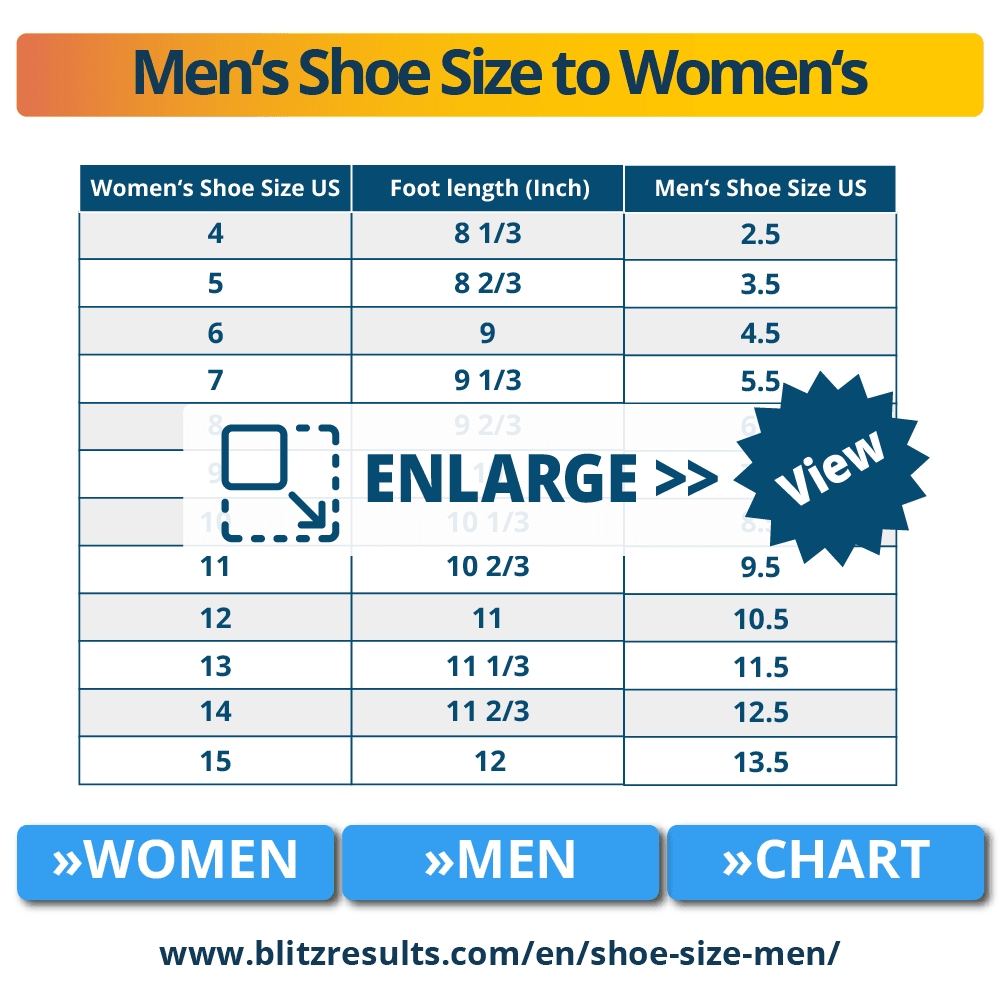This article provides a straightforward method for accurately measuring shoe size at home, ensuring a perfect fit and offering detailed size conversion charts for both men and women.
Women’s Shoe Size Chart
A comprehensive guide to US women’s shoe sizes and corresponding foot lengths in inches.
| US Women's Shoe | Foot Length in Inches |
|---|---|
| 6 | 9 |
| 6.5 | 9 1⁄6 |
| 7 | 9 1⁄3 |
| 7.5 | 9 1⁄2 |
| 8 | 9 2⁄3 |
| 8.5 | 9 5⁄6 |
| 9 | 10 |
| 9.5 | 10 1⁄6 |
| 10 | 10 1⁄3 |
| 10.5 | 10 1⁄2 |
| 11 | 10 2⁄3 |
| 11.5 | 10 5⁄6 |
| 12 | 11 |
Women’s Shoe Width Chart
Details on the width of women’s shoes in the US, categorized from narrow to extra-wide.
| US Size | Narrow (AA) | Average (B) | Wide (C/D) | Extra-Wide (E) |
|---|---|---|---|---|
| 6 | 2 15/16" | 3 5/16" | 3 11/16" | 4 1/16" |
| 6.5 | 3" | 3 3/8" | 3 3/4" | 4 1/8" |
| 7 | 3 1/16" | 3 7/16" | 3 13/16" | 4 3/16" |
| 7.5 | 3 1/8" | 3 1/2" | 3 7/8" | 4 1/4" |
| 8 | 3 3/16" | 3 9/16" | 3 15/16" | 4 5/16" |
| 8.5 | 3 1/4" | 3 5/8" | 4" | 4 3/8" |
| 9 | 3 3/8" | 3 11/16" | 4 1/16" | 4 7/16" |
| 9.5 | 3 3/8" | 3 3/4" | 4 1/8" | 4 1/2" |
| 10 | 3 7/16" | 3 3/4" | 4 3/16" | 4 9/16" |
| 10.5 | 3 1/2" | 3 7/8" | 4 1/4" | 4 5/8" |
| 11 | 3 9/16" | 3 15/16" | 4 5/16" | 4 11/16" |
| 12 | 3 11/16" | 4 1/16" | 4 7/16" | 4 13/16" |
Men’s Shoe Size Chart
A list of US men’s shoe sizes along with the foot length in inches for each size.
| US Men's Shoe | Foot Length in Inches |
|---|---|
| 7 | 9 5⁄6 |
| 7.5 | 10 |
| 8 | 10 1⁄6 |
| 8.5 | 10 1⁄3 |
| 9 | 10 1⁄2 |
| 9.5 | 10 2⁄3 |
| 10 | 10 5⁄6 |
| 10.5 | 11 |
| 11 | 11 1⁄6 |
| 11.5 | 11 1⁄3 |
| 12 | 11 1⁄2 |
| 12.5 | 11 2⁄3 |
| 13 | 11 5⁄6 |
| 13.5 | 12 |
| 14 | 12 1⁄6 |
| 14.5 | 12 1⁄3 |
| 15 | 12 1⁄2 |
| 15.5 | 12 2⁄3 |
Men’s Shoe Width Chart
Information on the width of men’s shoes in the US, ranging from narrow to wide.
| US Size | Narrow (C) | Average (D) | Wide (E) |
|---|---|---|---|
| 7 | 3 3⁄8" | 3 5⁄8" | 3 3⁄4" |
| 7.5 | 3 3⁄8" | 3 11⁄16" | 3 15⁄16" |
| 8 | 3 1⁄2" | 3 3⁄4" | 3 15⁄16" |
| 8.5 | 3 5⁄8" | 3 3⁄4" | 4" |
| 9 | 3 5⁄8" | 3 15⁄16" | 4 1⁄8" |
| 9.5 | 3 11⁄16" | 3 15⁄16" | 4 1⁄8" |
| 10 | 3 3⁄4" | 4" | 4 3⁄16" |
| 10.5 | 3 3⁄4" | 4 1⁄8" | 4 5⁄16" |
| 11 | 3 14⁄16" | 4 1⁄8" | 4 6⁄16" |
| 11.5 | 3 14⁄16" | 4 3⁄16" | 4 8⁄16" |
| 12 | 3 14⁄16" | 4 4⁄16" | 4 10⁄16" |
| 12.5 | 3 15⁄16" | 4 5⁄16" | 4 10⁄16" |
| 13 | 4" | 4 6⁄16" | 4 12⁄16" |
| 13.5 | 4 1⁄16" | 4 7⁄16" | 4 13⁄16" |
| 14 | 4 2⁄16" | 4 8⁄16" | 4 14⁄16" |
| 14.5 | 4 3⁄16" | 4 9⁄16" | 4 14⁄16" |
| 15 | 4 4⁄16" | 4 10⁄16" | 4 14⁄16" |
How to Measure Your Shoe Size and Width at Home

- Measure your feet in the afternoon or evening because they expand after a day of walking and standing. Measuring in the morning may lead to buying shoes that are too small.
- Place your foot on a sheet of paper on the floor. Secure the paper with tape to prevent it from moving.
- Use a pen to draw the outline of your foot. Make sure the pen is straight up, perpendicular to the paper.
- Find the longest point from your heel to your longest toe and measure this distance.
- Use this measurement with a shoe size chart or calculator to find your correct shoe size.
- Tip: If shoes often feel tight, measure both feet and use the measurement of the larger foot for shoe shopping. If there’s a big difference between your feet’s sizes, consider custom shoes or insoles.
Conversion: Men’s Shoe Size to Women’s and vice versa

Use this table to easily convert men to women shoe size and women to men shoe size.
| US Women's Shoe Size | US Men's Shoe Size | Foot Length in Inches | UK Shoe Size (Unisize) | EU Shoe Size (Unisize) |
|---|---|---|---|---|
| 6 | 4.5 | 9 | 4 | 36.5 |
| 6.5 | 5 | 9 1⁄6 | 4.5 | 37 |
| 7 | 5.5 | 9 1⁄3 | 5 | 37.5 |
| 7.5 | 6 | 9 1⁄2 | 5.5 | 38 |
| 8 | 6.5 | 9 2⁄3 | 6 | 39 |
| 8.5 | 7 | 9 5⁄6 | 6.5 | 39.5 |
| 9 | 7.5 | 10 | 7 | 40 |
| 9.5 | 8 | 10 1⁄6 | 7.5 | 40.5 |
| 10 | 8.5 | 10 1⁄3 | 8 | 41.5 |
| 10.5 | 9 | 10 1⁄2 | 8.5 | 41.5 |
| 11 | 9.5 | 10 2⁄3 | 9 | 42.5 |
| 11.5 | 10 | 10 5⁄6 | 9.5 | 43.5 |
| 12 | 10.5 | 11 | 10 | 44 |
| 12.5 | 11 | 11 1⁄6 | 10.5 | 44.5 |
| 13 | 11.5 | 11 1⁄3 | 11 | 45.5 |
Insights from our Lab
This is how we work: watch the video and see how we measure and research in our lab.
